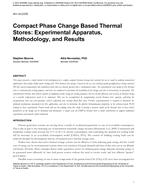Click here to purchase
Phase change phenomena which occur by boiling or flashing are found in many applications such as heat exchangers, cooling of power current carrying devices, and in oil and gas industry. The objective of this study is to design an experimental setup to test pool boiling heat transfer for a quenched vertical cylinder. The constructed setup consists of a transparent heat-treated plexiglass tank with the dimensions of 30x40x35 cm3 and it is filled with water. The water is heated uniformly to reach a subcooled temperature using two electrical heaters to achieve steady state condition before quenching. A cylindrical vertical ceramic furnace with a maximum power of 1480 W is used to heat the test sample to the desired temperature that is well above the minimum film boiling temperature (TL) in order to capture the film boiling behavior. The test sample is a cylindrical rod with a diameter of 1 cm and a length of 5 cm.The temperature of the cylinder was monitored during quenching using embedded K-type thermocouple that is connected to a data acquisition system.The data acquisition is used to record temperature change over the quenching time that is used to observe film boiling, transition boiling, nucleate boiling,and natural convection. Experiments are done to observe the quenching curve different liquid subcooled temperatures. Also, to compare smooth androughened surface microstructures of the rod to understand the effect of roughness on the heat transfer mechanisms. The results show significant decrease inthe cooling time as the water temperature reduced. The results also indicate that increasing surface roughness enhances the heat transfer rate.
Citation: 7th International Conference on Energy Research and Development
Product Details
- Published:
- 2019
- Number of Pages:
- 7
- Units of Measure:
- Dual
- File Size:
- 1 file , 560 KB
- Product Code(s):
- D-2019ICERD7-005


